What does JTF mean in US GOVERNMENT
Joint Task Force (JTF) is a type of military operation that involves the integration of two or more branches of the armed forces for a specific purpose. It is usually formed as part of a multinational coalition and tasked with achieving a common goal, such as resolving an international dispute, responding to a disaster or performing peacekeeping duties. Joint task forces are necessary because of the commitment needed from each branch in order to succeed at whatever mission they are assigned.

JTF meaning in US Government in Governmental
JTF mostly used in an acronym US Government in Category Governmental that means Joint Task Force
Shorthand: JTF,
Full Form: Joint Task Force
For more information of "Joint Task Force", see the section below.
Purpose
The main purpose of joint task forces is to combine the different capabilities and strengths of each service component in order to achieve an operation's objectives more effectively and efficiently than any single component could do alone. This includes combining airmen, sailors, soldiers, marines, and coast guardsmen who specialize in various areas to form diverse teams capable of tackling complex problems. Examples include counterterrorism operations by combining intelligence gathering from multiple agencies with military capabilities from all branches; humanitarian operations which combine medical units from all services to provide aid; or special reconnaissance missions which utilize elements from all branches. Ultimately, this allows different branches to bring their abilities together on one team for maximum efficiency and effectiveness.
Benefits
The most significant benefit gained through joint task force collaboration is achieving operational goals more quickly and efficiently than would be possible with separate components operating independently of one another. In addition, sharing resources across components can help each service save money while still providing the same level of capability. For example, if one component requires specialized transportation services that another component has already acquired, both services can reduce spending by splitting costs instead of purchasing duplicate assets. Furthermore, having personnel with experience in multiple branches can lead not only to improved resource management but also enhanced coordination between members when planning missions or executing them in the field. Lastly, joint task forces allow members to share expertise across components which results in increased combat readiness and better informed decision-making.
Essential Questions and Answers on Joint Task Force in "GOVERNMENTAL»USGOV"
What is JTF?
JTF stands for Joint Task Force, which is a temporary collaboration between two or more distinct organizations to combine their efforts in order to achieve an important project goal.
What type of projects can be accomplished using JTFs?
JTFs are commonly used to achieve large-scale projects that require the combination of multiple disciplines, skills, and resources. Examples of such projects include disaster relief operations, humanitarian aid missions, military operations and counter-terrorism initiatives.
Who typically participates in Joint Task Forces?
Joint Task Forces typically involve participants from multiple organizations such as governments, non-governmental organizations (NGOs), militaries, and private industry.
Where does the funding for a JTF come from?
Each organization involved in the task force usually provides its own resources and finances for its participation. These include personnel involvement, time commitment and financial contributions. The total amount of resources provided by all participating parties is then pooled together to form the budget for the task force's activities.
How is command and control handled within a JTF?
Depending on the mission type and situation, command and control within a Joint Task Force can be shared between one or more commanders who are usually representatives from the respective member organizations. Decisions are often made through consensus by agreement among all members of the task force.
When should a joint task force be formed?
A Joint Task Force should typically be formed when there is a need to achieve an important project goal which requires different types of knowledge and resources that would not be available without combining forces across different organizations.
How long does a joint task force typically last?
The duration of a Joint Task Force depends on the complexity of the mission objectives as well as how quickly these objectives can be achieved. It could range from days or weeks up to several months or even years depending on the circumstances and requirements involved in completing it successfully.
Final Words:
In conclusion, Joint Task Forces are beneficial because they combine abilities from different branches into unified teams that can tackle difficult challenges more effectively than any single component could do alone. They also help save money by allowing services to share resources rather than purchase duplicate assets and create opportunities for cross-service communication that leads to improved coordination during planning and execution phases. When these benefits are taken into account it becomes clear that use of joint task forces is highly advantageous regardless of mission type being undertaken.
